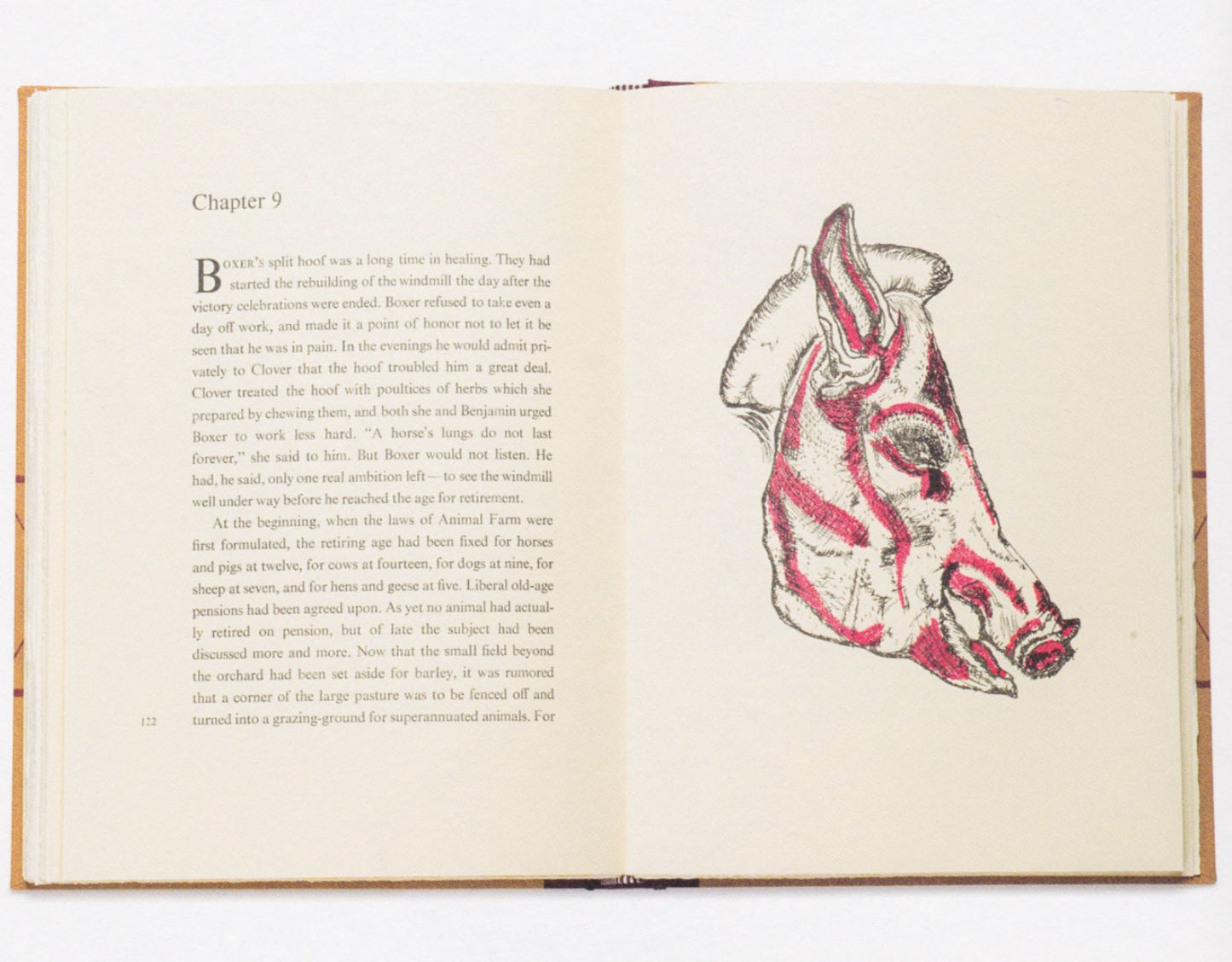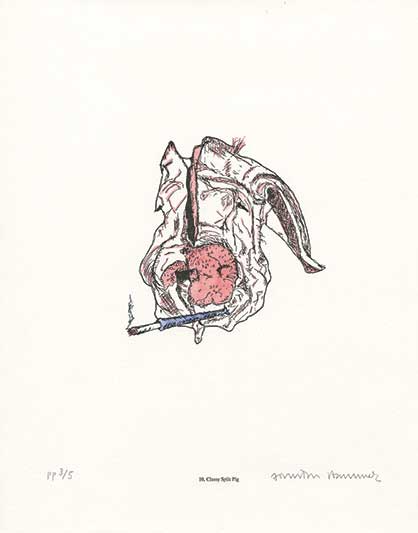Animal Farm
Animal Farm
The novel by George Orwell, introduction by Peter Stansky, with 24 prints by Jonathan Hammer, signed by the artist, with extra suite of prints, December 2013. $6,000.00
Publication 99
ADD TO CARTGeorge Orwell was the wintry conscience not only for England, but for much of the world through his two most influential books Animal Farm(1945) and Nineteen Eighty-Four (1949). In Animal Farm, the farm animals rebel against their subjugation and drive out the farmer and his wife. The pigs take charge, and one of them, named Napoleon, becomes dictator. As the Stanford University historian Peter Stansky writes in his introduction, “Orwell is a writer of extraordinary power and this may be his greatest masterpiece, a perfect text. As a fable about human nature it transcends the political era in which it was written. It is in so many ways a despairing book, but it has such compassion and empathy. In the end, there is still a glimmer that possibly some day we might create a better and more equal society.”
THE AUTHOR
George Orwell was born Eric Arthur Blair in 1903 in India, where his father was a civil servant supervising the opium trade. He returned to England in 1927 and dedicated himself to being a writer, eventually adopting the pseudonym of George Orwell, and publishing his first book, Down and Out in Paris and London, in 1933. Soon after the outbreak of the Spanish Civil War, Orwell went to Spain as a reporter and joined the militia of a semi-Trotskyite group, the poum. Orwell’s ideas about how the socialist revolution was betrayed by the Communists are the basis for his fable Animal Farm, published in 1945. It was the work that made him internationally famous. His novel Nineteen Eighty-Four, published in 1949, has a similar theme. The book made permanent contributions to the language, such as Big Brother, the Thought Police, and two plus two equals five, and has special relevance to government surveillance as practiced today. Orwell died in 1950 of tuberculosis.
THE ARTIST
Jonathan Hammer was born in 1960 in Chicago. He graduated from Bard College and studied bookbinding at the London College of Printing. For a time, when he lived in San Francisco, he worked at Arion Press as a bookbinder. Then he went on to fame and fortune as an artist. Hammer has had more than forty one-person exhibitions. For twenty-five years he has worked in several mediums including works on paper, photography, unique books, sculptures, and prints, as well as his signature screens made from marquetry of exotic skins. Hammer has exhibited widely in Germany, Switzerland, Norway, France, England, Spain, Mexico, and the United States. He has had nine solo exhibitions in New York (including five at the Matthew Marks Gallery). Along with numerous group exhibitions in museums, Hammer has had solo shows in Geneva at the Centre d’Art Contemporain and the Berkeley Art Museum. His works are in many private and public collections including: the Museum of Modern Art, New York; San Francisco Museum of Modern Art; Museum of Contemporary Art, Los Angeles; Hammer Museum, UCLA; Berkeley Art Museum; Whitney Museum of American Art; New York Public Library; and the Jumex Collection. An authority on Zurich Dada, Hammer has published his critical writings on the subject in his book Ball and Hammer, Yale University Press, 2002. Hammer has recently completed a cycle of large sculptures in porcelain with the Bernardaud Foundation in Limoges, France. He has received honors from Art Matters, Pro Helvetia (the Swiss Arts Council), and The Memorial Foundation for Jewish Culture. He is represented by the Miyako Yoshinaga Gallery, New York.
ARTIST’S NOTE
I live in a Spanish village of twenty-eight human inhabitants, many pigs, about a thousand sheep, and countless chickens. There was once an ass; he was euthanized when he was too old to work. Laguarres has two streets, but I count at least four distinct barrios and five cliques. Divisions from the Civil War still run deep. Spanish friends laugh when we tell them where we live. La Guarra is slang for a filthy sow.
One reads Animal Farm as a parable, with a strong moral lesson to be learned, maximally pedagogical. There is not a lot of room for art. No wonder the book is taught in every school! In historiographical terms the literal struggles Orwell recounts are fading fast. He subtitles Animal Farm a fairy story. What if we actually read it as such, not as a factual text to be illustrated, but as a guide to an archetypal sense of human interaction and desire? Perhaps satire and corruption are all around us. For me, the interest lies in the place where the art sparks. There is nothing more deliciously frightening than the collision/collusion of the sneering repressed self-deprecating right as it meets and melds with the disdainful well-meaning passive left. In the village, I live within the midst of this equation every day. Violence is nearby and skin deep. I have always worked with books and bindings. Skin is my tool, to be cut and skived, hacked, and chopped. Write with the knife. Expose the extreme to the bone.
Here, like everywhere, we have a veneer of education that somehow holds it all together in civility. But education in the hands of whom, as a tool for what purpose? Who is the victim and who is the victimizer? Who is the master and who is the gelding? A silk purse from a sow's ear. Pearls juxtaposed with swine. Indeed, what more natural way for me to make Animal Farm art, than through the welcome of butchery and finery in cohabitation.
FORMAT
The Arion Press edition of Animal Farm is large octavo in format, 10-1/8 by 7-1/2 inches, of 156 numbered text pages, plus 24 unnumbered leaves for the illustrations, for a total of 204 pages. The type is Times New Roman in Monotype, with display sizes set by hand. It was printed by letterpress on Zerkall ivory book, a German mouldmade paper. The 24 relief prints are printed by letterpress from polymer plates made from films scratched by the artist with an etching needle for the black images, with photo-polymer plates made from overlay drawings in pencil for the red tints. The binding is three-piece cloth, with a maroon spine and ochre sides, imprinted with images of the gate of Manor Farm on the back and the gate of Animal Farm on the front, with the same materials used for the slipcase. This is the ninety-ninth publication of the Arion Press. The book edition is limited to 300 numbered copies for sale, signed by the artist.
This copy is accompanied by the extra suite of twenty-four relief prints, the same images as appear in the book. The images were printed in black and hand-colored in red and one of four colors. The paper is Zerkall Natural white, 15 " by 12 1/2", encased is a portfolio covered in maroon buckram with an ochre titling label on the front. The suite is in an edition of 30 numbered sets, plus 5 artist's proofs and 5 publisher's proofs, with each print numbered and signed by the artist.
POSTAGE: Additional postage may apply; please inquire for details.
Share



